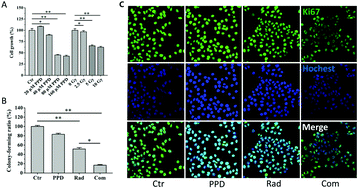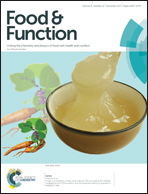20(s)-Protopanaxadiol (PPD) increases the radiotherapy sensitivity of laryngeal carcinoma†
Abstract
Laryngeal carcinoma (LC) is one of the most prevalent malignant tumors in the head and neck area. Due to its high morbidity and mortality, LC poses a serious threat to human life and health. Even with surgical removal, some patients were not sensitive to radiotherapy or experienced transfer or recurrence. 20(s)-Protopanaxadiol (PPD), a natural product from Panax ginseng, has been reported to have cytotoxic effects against several cancer cell lines. However, whether it can improve the radiation sensitivity and the underlying mechanism of PPD's sensitization effect is still unknown. Herein, from in vitro and in vivo experiments, we found that the combination of PPD and radiation not only significantly inhibited proliferation and induced apoptosis, but also suppressed the tumor growth in mouse models. These findings confirmed the role of PPD in enhancing the sensitivity of radiotherapy. Moreover, our work showed that the expression levels of mTOR and its downstream effectors decreased remarkably after PPD addition when compared to radiation only. This result suggested that PPD's excellent synergistic effects with radiation might be associated with the down-regulation of the mTOR signaling pathway in Hep-2 cells.



 Please wait while we load your content...
Please wait while we load your content...